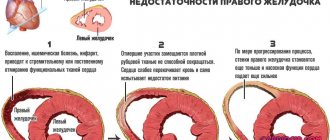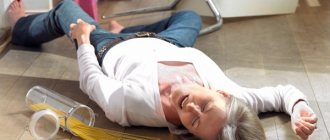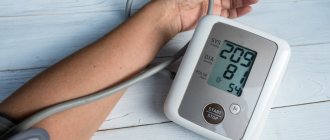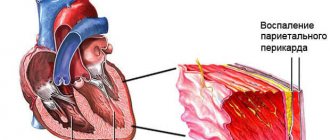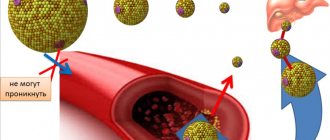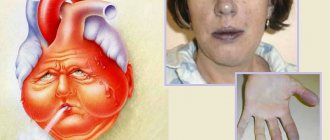At what pressure does fainting occur?
One of the common causes of this condition is considered to be low blood pressure and vegetative-vascular dystonia. The pathology is marked by cerebral circulatory disorders. As a result, a person often feels dizzy and may lose consciousness. For example, when the tonometer is 90/60 mm Hg.
Presyncope with VSD is usually marked by a feeling of weakness due to insufficient vascular tone.
With high blood pressure , a symptom such as fainting is not a rare exception. During a hypertensive crisis, the human body simply does not have time to rebuild and adapt. The load on the heart increases and a lack of oxygen occurs. As a result, fainting may occur. For example, a person may lose consciousness at a reading of 190/110 mmHg.
These phenomena must be constantly prevented so that they do not interfere with living a full life in the future. To do this, you need to take care of your health and avoid stressful situations. Hypertensive and hypotensive patients monitor their work pressure in a timely manner, take the necessary medications and constantly visit a cardiologist.
High blood pressure
Many people after 45 years of age gradually begin to develop problems with the cardiovascular system. High blood pressure, caused by poor lifestyle and stress, is one of the most common and dangerous ailments.
The symptoms of hypertension are not immediately noticeable, so treatment is not started on time. This is precisely what is fraught with possible complications.
Blood circulation is gradually impaired due to nervous situations and frequent worries. Further, the cardiovascular system cannot cope with the load and heart failure develops. Therefore, as soon as the first symptoms of the disease begin to appear, you should immediately undergo examination.
The first warning signs of the disease may include shortness of breath, frequent dizziness and breathing problems.
During a hypertensive crisis, the supply of oxygen to the brain is cut off and the person may lose consciousness. Usually such attacks pass within just a few minutes. After this, the condition gradually improves. For some time after the attack, the victim may still feel weak.
Experts note that fainting occurs with the following blood pressure levels:
- For females, these are numbers from 140 to 90 mmHg. Art.;
- For males, these indicators range from 160 to 100 mmHg. Art.
If a person does not have chronic hypertension, but his blood pressure has risen sharply by 20 units or more, he is already at risk.
Hypertensive patients should try to avoid nervous tension, stress and strong emotional tension.
Causes
There are many reasons why a person faints. In most cases, the culprit is a violation of vascular tone. The person suddenly changes his body position (stands up), and at this time the blood stagnates in the legs.
Violation of vascular tone is often a consequence of VSD. Modern doctors have not yet fully studied this disease, so its treatment does not always give positive results.
Note! A person who has been diagnosed with VSD is prohibited from suddenly changing body posture and temperature conditions.
Most often, VSD develops in people with an asthenic physique. They have a very difficult time with low blood pressure, which often provokes fainting. Statistically, women are more prone to blackouts than men.
Most often a person loses consciousness due to:
- fasting (diet);
- prolonged stress;
- overwork;
- lack of physical activity;
- infections;
- bad habits;
- experienced strong emotional shock;
- decrease in pressure;
- bearing a child;
- glucose deficiency in the body;
- anemia;
- food or chemical poisoning;
- abnormal heart rhythm;
- injuries.
Diet often provokes fainting.
Children are also susceptible to hypotension. In them, this condition occurs due to a genetic predisposition or external factors. The risk group includes children who live in difficult conditions and experience chronic fatigue. In addition to hypotension, they may suffer from VSD.
If a child often faints, this can be regarded as a complication of hypotension or VSD. In this case, fainting is only a symptom of a disease that requires long-term therapy.
If attacks begin to occur with enviable regularity, you need to urgently seek qualified help.
Low blood pressure
Due to too low blood pressure, oxygen starvation also occurs. The brain is affected and short-term syncope may occur.
Hypotonic patients can easily notice a faint state. At this time, severe weakness and dizziness often occur, and in rare cases, even a gag reflex occurs.
In the event of a severe attack, the victim may experience convulsions.
In people who do not suffer from hypotension, blood pressure can fall for various reasons. Among them the most common:
- Blood loss;
- Injuries and serious bodily harm;
- Heatstroke;
- Shock.
To prevent fainting, such people need to train their blood vessels in various ways. For example, you can harden the body. In this case, it is better to start with wiping, then move on to a contrast shower. Massages and saunas are also good for training veins and blood vessels.
First self aid
It is worth noting that natural loss of consciousness is a phenomenon worth paying attention to. The types of fainting make it possible to determine the presence of some pathology, and timely access to the hospital will help to avoid serious complications.
Fainting is accompanied by various symptoms. Before losing consciousness, a person experiences weakness and dizziness, sounds seem to become distant, and dark spots appear before the eyes. In this case, you need to lower yourself as quickly as possible so as not to cause harm to your body. After this, you need to try to take a horizontal position and raise your legs slightly above head level, as well as ensure maximum flow of fresh air.
You should not resort to such dubious methods that can provoke loss of consciousness. Sometimes, in order for others to really think so, it is enough just to show a little artistry and exclaim: “Oh, I almost fainted!”
If the cardiovascular system malfunctions, a person may lose consciousness. Fainting occurs when there is a jump in blood pressure and requires first aid to the victim.
A person's blood pressure is high or too low and can be accompanied by various symptoms. More often with headaches, nosebleeds, loss of strength, even loss of consciousness. This condition is interpreted in medicine as “Syncope”.
This occurs when there is a sharp jump in blood pressure when the brain does not have enough oxygen. The likelihood of such a symptom occurring is much higher in hypertensive patients who experience frequent stress and anxiety.
First aid
If a person faints, the following urgent measures must be taken:
- Check your pulse first. If palpitations are noted, then you can proceed to the next step. If there is no pulse, immediate resuscitation is needed.
- Raise your legs up while the victim is lying down. To do this, you can put something under your feet. This will help direct blood circulation towards the brain.
- Next, you need to bring cotton wool or a cotton pad soaked in ammonia to your nose. This is the most effective way to bring a person to consciousness.
- If ammonia is not on hand, you can try other movements. Free the victim's throat from excess clothing and try to bring him to consciousness by patting his cheeks.
- You can also use cold water. It's better to wet a cloth and wipe your face with it or spray it a little.
A person who has lost consciousness needs fresh air, so it is imperative to open the windows in the room.
First aid for fainting
When a person faints, it is necessary to unbutton clothes so that air can better enter the lungs. To remove the victim from the place where the unfavorable factors are located, it is necessary to put him on the floor and turn him on his side or sit him down and lower his head so that it is between his legs.
You need to start splashing water in the face, lightly hit the cheeks, and let the ammonia smell. It is necessary to measure blood pressure and pulse; if no action brings results, then urgently call for medical help.
If it happens that a person often loses consciousness even with slight stress, you need to seek help from a doctor. You should always pay attention to your well-being and should not turn a blind eye to fainting, as this may indicate that there are some diseases.
Classification of fainting
Fainting can be of three types, depending on the cause that caused it:
| Orthostatic | They appear due to a sudden change in position, due to strong emotions, or physical activity. |
| Nervous reflex | Appear due to autonomic dysfunction, taking certain medications, or intoxication. The main reason for such fainting is the insufficiency of vasoconstrictor reflexes. |
| Cardiac | They are usually caused by various heart ailments (arrhythmia, defect, etc.) |
Types of loss of consciousness with low blood pressure
Falls can be due to various reasons, but most often due to pressure. A person loses consciousness both with low and high levels.
Fainting with low blood pressure is not uncommon. This is due to the fact that due to low tone of blood vessels, blood circulates more slowly than necessary. The body's response to various factors of the external and internal environment is slowed down. As a result, cells throughout the body experience oxygen starvation. This has a particularly negative effect on the functioning of the cerebral cortex. The brain slows down its activity in order to save vital energy, which leads to loss of consciousness.
Experts distinguish three main types of fainting with low blood pressure:
- Associated with the occurrence of a specific situation. Most often with increased physical activity. For example, a sluggish circulatory system does not have time to adapt to the high load on the body that occurs during a morning jog. Or severe overstrain of the muscles of the whole body with prolonged hiccups can lead to a short-term loss of consciousness.
- Related to blood parameters. Low iron and hemoglobin levels cause the blood to become insufficiently oxygenated. As is known, it is its deficiency that leads to malfunctions of the cerebral cortex. The problem can be solved by adjusting the diet. For example, you need to eat more apples, pomegranates, and include beef liver and red meat in your diet. Pomegranate juice increases hemoglobin well.
- Associated with psychological and emotional overload. For example, the loss of a loved one or, conversely, the birth of a child are stressful situations. Falls are often associated with various persecution delusions and phobias. For example, a strong fear of the dark or confined spaces can lead to loss of consciousness.
There are other types. For example, loss of consciousness can be triggered by a sudden change in body position, especially a rapid rise from a lying position.
Treatment and prevention
Following some preventive measures can help avoid syncope.
To do this you need:
- Do not stay in the heat for a long time;
- Drink enough drinking water, especially in summer;
- Avoid stress;
- Reduce alcohol consumption to a minimum;
- Avoid staying in one position, doing warm-up or walking, or massaging muscles;
- Hypertensive and hypotensive patients take medications on time. It is also important that all medications were prescribed only by the attending physician.
If you are already feeling faint, you should immediately take a lying or sitting position. This method will help reduce the risk of fainting.
Treatment of the disease
The advisability of treating the disease depends on the cause of its occurrence. If fainting is situational in nature, it is enough to avoid the catalyst causes. If you become unconscious while drawing blood, notify your healthcare provider.
If the pathology develops against the background of anemia, the patient needs careful diagnosis and treatment. Anemia is not an independent disease, so you need to get rid of the reasons that provoked its development.
In case of low blood pressure, you need to drink enough water, use a fractional diet and drink drinks containing caffeine.
If fainting is the result of an allergic reaction to a drug, you should immediately inform your doctor. The specialist will select a suitable analogue.
Causes of pathology
The occurrence of syncope is usually associated with cardiovascular pathologies. Because of them, blood circulation is disrupted and sufficient oxygen does not reach the brain. Such ailments can begin to develop at any age, even in children. The most common cause of fainting is arrhythmia.
Hypertensive patients should be careful with physical activity and should never overdo it. Sometimes overwork also becomes a provocateur of fainting.
Taking certain medications without following the dosage can cause fainting in rare cases.
Other causes of fainting:
- Lung pathologies;
- Traumatic brain injuries;
- Pain shock;
- Diabetes;
- Prolonged fasting;
- Being in a stuffy room.
Causes of fainting
Syncope can occur due to the influence of physical and other factors on the functioning of the brain and other body systems. The main cause of loss of consciousness is considered to be a temporary disturbance of blood circulation in the brain and a lack of oxygen in its tissues (hypoxia).
What causes fainting:
- low blood pressure, orthostatic hypotension;
- hypotonic or hypertensive crisis;
- spasms and vasoconstriction;
- age-related changes (puberty, menarche, menopause);
- state of shock;
- bradycardia, tachycardia;
- a decrease in blood ejection during heart contraction (the norm is 55-70% of its total amount in the organ);
- cardiac diseases;
- disorder of the autonomic nervous system, impaired regulation of contractions of the vascular walls;
- increased ICP (intracranial pressure) and the pathologies that caused it;
- renal and liver failure;
- low blood levels of electrolytes and sugar;
- bleeding and dehydration;
- poisoning with alcohol, nicotine, chemical, toxic, narcotic and medicinal substances;
- increased emotional excitability, mental disorders;
- blood pressure-lowering medications (side effects during treatment);
- hyperventilation syndrome, frequent and deep breathing;
- injuries;
- deficiency of nutrients in the body, low hemoglobin levels (diet, anemia);
- mental or physical fatigue, nervous tension;
- lack of oxygen in the air, extreme situations.
Some people provoke fainting on purpose, without thinking about the consequences of its influence on the body systems and brain tissue. In this case, the frequency of syncope does not indicate the presence of pathological processes in the body, but rather a person’s experiments with a combination of physical activity, breath-holding, improper daily routine, diets, and refusal to sleep. This is what can trigger the onset of serious illnesses.
Consequences of artificially induced fainting:
- traumatic brain injuries, damage to bone and soft tissues of the face, scars and scars due to a fall;
- due to the frequent use of ammonia, the reaction to the smell disappears and it is not possible to quickly bring a person to consciousness with the help of the drug;
- disruption of the respiratory and cardiac centers, endocrine system;
- migraine and dizziness;
- damage to brain tissue (necrosis, memory loss, loss of coordination);
- spontaneous emptying of the bladder and/or bowel due to relaxation of the sphincters of the anus or urinary system.
Regardless of the cause of syncope, a person needs to receive prompt medical attention to avoid irreversible processes.
Associated symptoms
Presyncope can be recognized by obvious signs.
These symptoms usually include: dizziness, ringing in the ears, spots before the eyes or other vision problems, and nausea. Sudden weakness and sweating are also often noted. Sometimes syncope can occur without such symptoms.
Typically, the duration of fainting ranges from 20 seconds to several minutes , but not more than five minutes. After loss of consciousness, the victim often feels weak and tired for some time.
Whatever the reasons for fainting, it is necessary to see a general practitioner and be examined.
It is important to try to take preventative measures every day and avoid such phenomena. Author of the article Svetlana Anatolyevna Ivanova, general practitioner
Clinical manifestations of syncope with pressure
Syncope has 3 stages of progression. This is a pre-syncope state, immediate fainting, the post-syncope phase. Loss of consciousness is preceded by deterioration in vision functions: blurry objects, darkening of the eyes. In the prefainting stage, muscle tone also decreases, sweating increases, weakness of the limbs, yawning, lethargy, nausea, palpitations, dizziness, and tinnitus appear.
In the second phase of syncope, the person loses consciousness. The pressure during fainting is reduced, unless the cause is a hypertensive crisis or intracranial hypertension. When consciousness is lost, shallow breathing, profuse sweating, pale skin are noted, the pulse quickens, although it is faintly palpable, skeletal muscle tone is lost, the hands and feet become cold, and the pupils dilate and do not respond to light.
In the post-syncope phase, disorientation, deafness, tinnitus, and headache do not last long. Sometimes memory is temporarily lost. After fainting, do not get up for about 20-30 minutes to reduce the likelihood of repeated syncope.
Fainting from pills
The neurologist prescribes a number of medications to his patients to normalize blood pressure. When used correctly and in a timely manner (following the instructions and recommendations of the doctor), unexpected and sudden surges in pressure stop. If the patient does not listen to the instructions of the professional, does not follow the instructions and exceeds the maximum permissible dose of medication, he may faint, which will be the first signal of danger to life and health. Therefore, you should always strictly follow the instructions and recommendations of the doctor.
How to provoke fainting: the most common methods
There are a number of brave people who are willing to faint on purpose in order to attract attention to themselves.
The easiest way to faint on purpose is to theatrically depict a short-term loss of consciousness in the best traditions of Russian theater.
However, not everyone has theatrical abilities; repeated attempts at unnatural fainting can cause a reaction from others that is exactly the opposite of what was expected. Therefore, the thought arises - how to provoke fainting?
Whatever the reason - the desire to attract the attention of a person you like, to cause leniency in an exam, to create a reason for refusing any type of activity (for example, a categorical reluctance to run a 10-kilometer cross-country race) - you should approach the problem of provoked fainting carefully and carefully plan your actions to faint on purpose.
Methods of provocation
If the violations described above do not frighten you, there are several types of provocation that can quite effectively provoke and deliberately faint.
- You should hold your breath for a few seconds (the longer the better), then inhale sharply, creating conditions for brain hypoxia.
- Create conditions for hyperventilation of the lungs - inhale and exhale deeply for several minutes, then hold your breath and throw your head back; As a result of brain hypoxia and blood redistribution, provoked fainting occurs.
- Another way to artificially create a redistribution of blood, or rather an outflow from the brain to the periphery: run quickly for a few minutes (blood flow will occur to the working muscles), then sit down sharply and stand up no less sharply - the provoked result will not take long to arrive.
- Squat intensely for several minutes, then hold your breath - even a strong man can deliberately faint after such an exercise.
For impressionable young ladies, products that create a colorful visual image and can cause fainting may be useful.
- Extensive open injury with profuse bleeding.
- A large number of mice, spiders, lizards or a bag of money - anything that causes a shocking impression and drives you into a stupor.
For particularly courageous people who do not have abstract thinking, but want to provoke fainting, fairly tough but effective measures can be useful.
- Medicines that sharply lower blood pressure. For example, a nitroglycerin tablet placed under the tongue while maintaining an upright body position will most likely provoke a short-term loss of consciousness.
- Prolonged fasting, lack of breakfast or lunch at the appointed time, combined with prolonged standing or walking will lead to the fact that almost anyone will faint on purpose.
- Excessively warm and thick clothing in combination with a stuffy, poorly ventilated room will bring the expected effect, especially if a person stands for a long time without sitting down.
- If it is very necessary to provoke and faint on purpose and at the same time there is absolutely nothing scary, you can hit yourself hard or fall on purpose and try to hit yourself harder.
Consequences and first aid
As is already becoming clear, an artificially induced loss of consciousness can lead to immediate and long-term, far from pleasant consequences.
Immediately after a specially created fainting spell (as well as after the most common unexpected one), a person may experience severe headache and dizziness, excessive salivation, nausea or even vomiting (as a result of low pressure), severe weakness and palpitations.
It’s good if after such a provocation a person only turns sharply pale or blue from hypoxia. Disruption of the functioning of the brain centers can provoke relaxation of the sphincter muscles (a kind of clamps) of the natural reservoirs of the human body.
That is, as a result of fainting, you can attract attention to yourself in an unflattering way - by involuntarily urinating or not holding back feces. It is clear that if you fall unsuccessfully from your own height, you can hit the surrounding objects quite hard and receive a serious traumatic brain injury and other injuries.
If the desire to provoke and faint is deliberately quite persistent, the method of provocation is chosen, you need to carefully prepare to level out the possible consequences. It is good to enlist the support of an accomplice and fall on him, and not on the floor. An assistant in such a difficult task must have the necessary skills in providing first aid.
The victim as a result of a specially provoked fainting (at this stage the cause is no longer important) must be provided with an influx of fresh air: open a window or window, ask sympathetic people around to move aside.
If the situation allows, raise your legs above your head, which will cause blood flow to the head. Massage the pain points deep in the tendons between the thumb and index finger on your hand. Give the victim hot sweet tea.
As a result of all of the above, it becomes clear that the desire to provoke and faint on purpose must be conscious, well-reasoned and previously prepared.
Source: https://swedmed.ru/obmorok/323-sprovotsirovat-obmorok.html
First aid methods and symptom prevention
Enter your pressure
130
on
90
Search in progress Not found
A short-term loss of consciousness does not cause serious harm to health. But the danger is the fainting itself: it can cause damage to the cervical spine, severe traumatic brain injury and even death.
Therefore, it is important to provide first aid in time
Immediately before fainting, a person may complain of a deterioration in general health: severe headache, dizziness, blurred vision and tinnitus, nausea. If these symptoms appear, you can do the following:
- Let the person smell cotton wool soaked in ammonia.
- Sit him down and tilt his head below his knees: this will increase blood flow to the brain.
- Massage the person's temples and earlobes, pat his cheeks.
If a person nevertheless faints, it is necessary:
- Hold it when you fall (if possible): this will prevent injury.
- Place the victim on a flat surface and place an object under his feet.
- Provide air flow to a person who has lost consciousness: free his neck from clothes, open the windows.
It is also recommended to measure blood pressure during fainting (if you have a blood pressure monitor). If it is elevated, you can place Nitroglycerin under the victim’s tongue. If you are unconscious for more than 5 minutes, you must call an ambulance. If a person who has fainted has trouble breathing or heart rhythm, cardiopulmonary massage must be performed before paramedics arrive.
Prevention of fainting with hypo- and hypertension comes down to eliminating factors that lead to an increase or decrease in blood pressure to critical levels. Recommended:
Avoid stress, mental and physical strain. Play sports, ride a bike. Do morning exercises every day and walk. Eat properly. It is necessary to consume a moderate amount of salt, fresh vegetables and fruits, cereals, lean fish and meat
You need to eat food at least 4-5 times a day in small portions.
Stop smoking and limit alcohol consumption as much as possible. Go for walks more often. Strengthen blood vessels: take a contrast shower, visit the pool, massage treatments. Get proper rest: sleep at least 8 hours a day. Drink at least 2 liters of water per day (it is especially important to drink enough fluid during the hot season). Ventilate the room regularly.
Everyone should know at what pressure people faint. Constant monitoring of blood pressure levels will allow timely initiation of treatment measures in case of a strong deviation from the norm. This is the only way to prevent loss of consciousness, improve the quality of life and prevent the development of health-threatening complications.
What causes it to develop?
Why does blood pressure decrease? There are two forms of hypotension, with different causes and clinical manifestations: acute and chronic.
First form. Acute hypotension - low blood pressure in various emergency situations, is a manifestation of acute vascular insufficiency: fainting, collapse, shock.
The causes of these conditions are life-threatening diseases, such as:
- myocardial infarction, pulmonary embolism, severe arrhythmias;
- severe intoxications (pneumonia, peritonitis, pancreatitis, poisoning, toxic infections, sepsis);
- heavy bleeding;
- immediate allergic reaction;
- severe injuries, especially to the brain and spinal cord.
These are emergency conditions in which very low blood pressure is recorded, down to undetectable numbers. It is necessary to increase the pressure as quickly as possible. This is the task of specialists in urgent situations.
Second form. Chronic hypotension is low blood pressure for a long period of time, to which the body adapts.
This may be a physiological condition (normal), for example, with a hereditary characteristic, in trained athletes during prolonged and regular physical activity, in people from high mountainous regions. In this case, no symptoms of hypotension occur in humans.
Primary hypotension is based on dysfunction of the central nervous system, in particular the vasomotor center of the brain and the autonomic nervous system, against the background of prolonged psycho-emotional overstrain, stress, chronic intoxication, insufficient sleep, depression, etc.
Primary hypotension develops against the background of a hereditary predisposition; a person’s constitutional characteristics and lifestyle play an important role. Secondary hypotension occurs as a symptom of diseases.
Its causes are anemia, rheumatism, insufficient function of the endocrine glands, tuberculosis, dystrophy, spinal osteochondrosis, etc.
https://youtube.com/watch?v=6VqerdSsqHE
How to lower blood pressure so you can faint
People with hypotension or hypertension are often concerned about the question at what pressure they faint, why it happens, and what are the signs of its approach. However, not only problems with blood pressure can cause it, but also age-related changes. However, the clinical picture is the same in almost all cases.
Regardless of the level of blood pressure (BP) or age, a person may lose consciousness for a short time. This condition lasts no more than 5 minutes and is called “fainting” or “syncope” in medicine. It occurs due to insufficient blood supply to the brain (BM), disturbances or damage to the cardiovascular system, nervous shock, various diseases and age-related changes.
In some cases, for example, with epilepsy or severe fright, a pre-fainting state does not occur before a fall.
But usually before and after syncope, a person cannot see objects clearly, severe weakness, lethargy, dizziness, and arrhythmia appear.
In other words, fainting is a sudden loss of consciousness due to a diffuse (widespread) decrease in metabolism in the tissues of the brain caused by an inadequate supply of blood and oxygen to the organ. A person switches off for several minutes, falls and can be seriously injured on furniture, steps, asphalt or other hard objects, since the incident often occurs at a height, on the street, in a cramped room or other unsafe place. In case of frequent phenomena or their unclear etiology, examination by a cardiologist, neurologist and other doctors is required.
Syncope can occur due to the influence of physical and other factors on the functioning of the brain and other body systems. The main cause of loss of consciousness is considered to be a temporary disturbance of blood circulation in the brain and a lack of oxygen in its tissues (hypoxia).
What causes fainting:
- low blood pressure, orthostatic hypotension;
- hypotonic or hypertensive crisis;
- spasms and vasoconstriction;
- age-related changes (puberty, menarche, menopause);
- state of shock;
- bradycardia, tachycardia;
- a decrease in blood ejection during heart contraction (the norm is 55-70% of its total amount in the organ);
- cardiac diseases;
- disorder of the autonomic nervous system, impaired regulation of contractions of the vascular walls;
- increased ICP (intracranial pressure) and the pathologies that caused it;
- renal and liver failure;
- low blood levels of electrolytes and sugar;
- bleeding and dehydration;
- poisoning with alcohol, nicotine, chemical, toxic, narcotic and medicinal substances;
- increased emotional excitability, mental disorders;
- blood pressure-lowering medications (side effects during treatment);
- hyperventilation syndrome, frequent and deep breathing;
- injuries;
- deficiency of nutrients in the body, low hemoglobin levels (diet, anemia);
- mental or physical fatigue, nervous tension;
- lack of oxygen in the air, extreme situations.
Some people provoke fainting on purpose, without thinking about the consequences of its influence on the body systems and brain tissue. In this case, the frequency of syncope does not indicate the presence of pathological processes in the body, but rather a person’s experiments with a combination of physical activity, breath-holding, improper daily routine, diets, and refusal to sleep. This is what can trigger the onset of serious illnesses.
Consequences of artificially induced fainting:
- traumatic brain injuries, damage to bone and soft tissues of the face, scars and scars due to a fall;
- due to the frequent use of ammonia, the reaction to the smell disappears and it is not possible to quickly bring a person to consciousness with the help of the drug;
- disruption of the respiratory and cardiac centers, endocrine system;
- migraine and dizziness;
- damage to brain tissue (necrosis, memory loss, loss of coordination);
- spontaneous emptying of the bladder and/or bowel due to relaxation of the sphincters of the anus or urinary system.
Regardless of the cause of syncope, a person needs to receive prompt medical attention to avoid irreversible processes.
A normal blood pressure level is considered to be 120/80 mmHg (Hg). An indicator within the range of 90/60 – 115/70 is considered to be acceptable low blood pressure, and within the range of 130/80 – 140/90 – elevated blood pressure. You can faint if there is a sudden decrease or increase in systolic blood pressure of more than 20 mmHg. Art., and diastolic - above 10 mm Hg. Art., so each person needs to know their individual level of pressure.
You are more likely to faint when your blood pressure is less than 60 mm Hg. Art.
At this level of pressure, the blood volume in the brain decreases, and oxygen deficiency occurs in its tissues.
Syncope has 3 stages of progression. This is a pre-syncope state, immediate fainting, the post-syncope phase. Loss of consciousness is preceded by deterioration in vision functions: blurry objects, darkening of the eyes. In the prefainting stage, muscle tone also decreases, sweating increases, weakness of the limbs, yawning, lethargy, nausea, palpitations, dizziness, and tinnitus appear.
In the second phase of syncope, the person loses consciousness. The pressure during fainting is reduced, unless the cause is a hypertensive crisis or intracranial hypertension. When consciousness is lost, shallow breathing, profuse sweating, pale skin are noted, the pulse quickens, although it is faintly palpable, skeletal muscle tone is lost, the hands and feet become cold, and the pupils dilate and do not respond to light.
In the post-syncope phase, disorientation, deafness, tinnitus, and headache do not last long. Sometimes memory is temporarily lost. After fainting, do not get up for about 20-30 minutes to reduce the likelihood of repeated syncope.
The victim is immediately turned to his side (or just his head), and access to fresh air is provided. Then they unbutton the clothes on the chest to facilitate breathing, place any objects under the feet to raise the feet above chest level.
You can bring consciousness to life using a cotton swab soaked in a solution of ammonia or vinegar, spraying cold water on the face, or patting the cheeks.
After this, the person should drink strong tea with dark chocolate or take a caffeine tablet, if there are no contraindications, for example, diabetes. If necessary, call the medical service.
Sometimes, in order to faint and lower blood pressure, it is enough to stand for a long time, for example, in a queue. Syncope attacks can be caused by a strict diet and intense exercise. There are many types of fainting, as well as the reasons that cause it, so after such an event it is recommended to consult a doctor.
There are a number of brave people who are willing to faint on purpose in order to attract attention to themselves. The easiest way to faint on purpose is to theatrically depict a short-term loss of consciousness in the best traditions of Russian theater. However, not everyone has theatrical abilities; repeated attempts at unnatural fainting can cause a reaction from others that is exactly the opposite of what was expected. Therefore, the thought arises - how to provoke fainting?
Whatever the reason - the desire to attract the attention of a person you like, to cause leniency in an exam, to create a reason for refusing any type of activity (for example, a categorical reluctance to run a 10-kilometer cross-country race) - you should approach the problem of provoked fainting carefully and carefully plan your actions to faint on purpose.
This is a short-term loss of consciousness, which is caused by a cessation or significant reduction in the supply of oxygen and other nutrients to the brain.
Everyone knows about the complex and delicate structure of the brain, but this part of the human body does not have its own reserves (depot) of nutrients and oxygen. Even with a slight disruption of the blood supply (for example, when fainting), the brain is the first to suffer, namely the cerebral cortex, which is responsible for the state of human consciousness and higher nervous activity of a person.
If you provoke and faint on purpose, the blood supply to the brain will inevitably be disrupted. Perhaps a single fainting spell will not cause any negative consequences. However, conditions of hypoxia (lack of oxygen) in the brain can cause irreversible consequences.
If you faint on purpose, you can then lose your memory of some events: forget what happened the day before, what preceded the fainting, even lose orientation in time and space in some way (forget the day of the week or today's date), some time later it will be difficult to concentrate and perform small precise movements.
It is not only the brain that suffers from hypoxia, although its damage is more significant. Provoked loss of consciousness disrupts the harmonious and smooth functioning of all vital organ systems: cardiovascular, respiratory, gastrointestinal, urinary, endocrine.
Brain hypoxia disrupts the functioning of the respiratory and cardiac centers. At the beginning of a specially provoked situation, a decrease in blood pressure and compensatory tachycardia is noted. Further (as consciousness returns), the pressure rises, but the tachycardia remains. This can lead to unwanted stress on the myocardium and heart rhythm disturbances.
The endocrine system perceives this specially provoked situation as stress and is rebuilt to compensate for it. The amount of so-called stress hormones - adrenaline, cortisone, cortisol - increases to increase blood pressure and stimulate the cardiovascular system. In combination with changes in the heart and great vessels, this can lead to profound disturbances in the blood supply to the myocardium and disruption of the conductivity of the heart muscle.
As a result, it turns out that if you provoke and faint on purpose, the consequences of the planned undertaking can be far from harmless.
If the violations described above do not frighten you, there are several types of provocation that can quite effectively provoke and deliberately faint.
- You should hold your breath for a few seconds (the longer the better), then inhale sharply, creating conditions for brain hypoxia.
- Create conditions for hyperventilation of the lungs - inhale and exhale deeply for several minutes, then hold your breath and throw your head back; As a result of brain hypoxia and blood redistribution, provoked fainting occurs.
- Another way to artificially create a redistribution of blood, or rather an outflow from the brain to the periphery: run quickly for a few minutes (blood flow will occur to the working muscles), then sit down sharply and stand up no less sharply - the provoked result will not take long to arrive.
- Squat intensely for several minutes, then hold your breath - even a strong man can deliberately faint after such an exercise.
For impressionable young ladies, products that create a colorful visual image and can cause fainting may be useful.
- Extensive open injury with profuse bleeding.
- A large number of mice, spiders, lizards or a bag of money - anything that causes a shocking impression and drives you into a stupor.
For particularly courageous people who do not have abstract thinking, but want to provoke fainting, fairly tough but effective measures can be useful.
- Medicines that sharply lower blood pressure. For example, a nitroglycerin tablet placed under the tongue while maintaining an upright body position will most likely provoke a short-term loss of consciousness.
- Prolonged fasting, lack of breakfast or lunch at the appointed time, combined with prolonged standing or walking will lead to the fact that almost anyone will faint on purpose.
- Excessively warm and thick clothing in combination with a stuffy, poorly ventilated room will bring the expected effect, especially if a person stands for a long time without sitting down.
- If it is very necessary to provoke and faint on purpose and at the same time there is absolutely nothing scary, you can hit yourself hard or fall on purpose and try to hit yourself harder.
As is already becoming clear, an artificially induced loss of consciousness can lead to immediate and long-term, far from pleasant consequences.
Immediately after a specially created fainting spell (as well as after the most common unexpected one), a person may experience severe headache and dizziness, excessive salivation, nausea or even vomiting (as a result of low pressure), severe weakness and palpitations.
It’s good if after such a provocation a person only turns sharply pale or blue from hypoxia. Disruption of the functioning of the brain centers can provoke relaxation of the sphincter muscles (a kind of clamps) of the natural reservoirs of the human body.
That is, as a result of fainting, you can attract attention to yourself in an unflattering way - by involuntarily urinating or not holding back feces. It is clear that if you fall unsuccessfully from your own height, you can hit the surrounding objects quite hard and receive a serious traumatic brain injury and other injuries.
If the desire to provoke and faint is deliberately quite persistent, the method of provocation is chosen, you need to carefully prepare to level out the possible consequences. It is good to enlist the support of an accomplice and fall on him, and not on the floor. An assistant in such a difficult task must have the necessary skills in providing first aid.
The victim as a result of a specially provoked fainting (at this stage the cause is no longer important) must be provided with an influx of fresh air: open a window or window, ask sympathetic people around to move aside. If the situation allows, raise your legs above your head, which will cause blood flow to the head. Massage the pain points deep in the tendons between the thumb and index finger on your hand. Give the victim hot sweet tea.
As a result of all of the above, it becomes clear that the desire to provoke and faint on purpose must be conscious, well-reasoned and previously prepared.
When you watch old films, you often see young ladies with curls in their hair and in beautiful fluffy dresses fainting at the sight of a handsome prince.
They deliberately pretended to be unconscious in order to achieve a goal, attract attention, or save a life.
If our ancestors did this, why can’t we use this technique today? This can help you avoid difficulties and help you find yourself in the arms of a loved one.
There are situations when the ability to plausibly faint will save a life.
You should feign fainting very carefully. A fall risks hitting you against a hard object.
The consequences of the prank can be the most unexpected:
- Head injury.
- Fracture of an arm or leg.
- Dislocation or sprain.
- Trauma to the cervical vertebrae.
- Concussion.
- Hematomas on the head, which can develop into a serious disease requiring surgery.
- A hip injury that will close the door for you in some sports sections, competitions and the dance floor.
- Knocked out tooth.
- Bitten tongue.
- If you hit your head while falling, you could lose your life. There are several points on the head, a blow to which will lead to death. Remember this!
This is all very serious. Concussions and head injuries are dangerous to life and health. The skill can be practiced. You will learn to accurately calculate your fall, avoiding injury.
5 rules for fainting for malingerers:
The legs should move away from the feet to the side. The knees land first, then the butt, then the torso.
If you start landing from the head, you will have to spend a long time collecting teeth and treating the concussion. Traumatic brain injuries are dangerous. Be sure to rehearse in front of a mirror; your body will react automatically if you conduct an experiment on people without preparation.
If the acting talents leave much to be desired, use a proven method. Breathing manipulations will allow you to truly lose consciousness.
Important! Every loss of consciousness has a bad effect on the brain. If more than two fainting events occur per year, the consequences will be dire.
The time spent unconscious is also important. A person cannot influence this; this condition is uncontrollable.
Prolonged fainting can result in coma. This is not a safe experiment at all. Remember this, use it in extreme cases.
4 ways to actually lose consciousness:
| № | Methods | Additional Information |
| 1 | Hold your breath and inhale sharply | The manipulation will create a powerful impulse: oversaturation with oxygen will allow you to lose consciousness, or lead to severe dizziness |
| 2 | Breathe as deeply as possible: inhale the air, exhale sharply. Continue the manipulation for 3 minutes, hold your breath and tilt your head back | This method allows you to turn off consciousness |
| 3 | Go for a run as far as you can. Stop abruptly, sit down and stand up abruptly | Helps to break down and feel darkening in the eyes. If you run for as long as possible, you can turn off consciousness |
| 4 | If running is not possible, do squats. Repeat the exercise as long as you have the strength. Then suddenly hold your breath | Don't forget to watch where you fall |
Real loss of consciousness is caused by simple manipulations. The downside is harm and health hazard.
It will not be possible to accurately adjust the time of fall. You can create conditions for the body to weaken.
People in good health will have to use one of the above techniques in addition:
- Starvation.
- Depressant.
- Dehydration.
- Severe stress.
- Clothing that tightly pinches the chest and abdomen, preventing normal breathing.
- Hit to the head.
These methods are effective, but harmful. A blow to the head is mentioned because it can cause loss of consciousness. To use it is to risk your life.
The blow can cause brain bleeding. The person will forever remain disabled, immobilized, blind, or die. One blow to a sensitive spot and death is guaranteed.
Fasting can weaken the body, but along with a faint state, be prepared for stomach problems: ulcers, gastritis, indigestion, colitis.
Such experiments leave consequences.
Tight clothing is an option that works on the principle of breathing manipulation. Lack of oxygen will contribute to fainting. Make sure there are people nearby who will provide first aid.
Use the above methods. This skill may one day save a life.
Example: a quarrel with a spouse or a jealous boyfriend, when he is ready to hit, does not let you out of the room, threatens. Fainting will scare him and force him to slow down.
But it’s better to lose consciousness using acting. Practice at home, on a soft surface.
Real fainting should not occur more than twice a year! Remember this, and read the possible consequences again.
Practice losing consciousness masterfully, bring your skills to perfection.
Other possible consequences of fainting:
- A person loses control of himself: you can fart while a beautiful knight carefully holds you in his arms.
- Involuntary loss of urine is the second possible consequence. This happens if you really wanted to go to the toilet before fainting.
- When you fall, your skirt rides up, your blouse may slide to the side, and your chest may be exposed.
Use safe ways to lose consciousness.
Giving help
Algorithm for helping an unconscious patient:
- If possible, try to support the person to avoid injury due to a fall.
- Laying the person on their side will help keep the airway open.
- Elevate your legs if possible.
- Remove the victim from tight clothing.
- Sprinkle your face with water, rub your ears and cheeks.
- Bring ammonia to your nose.
- Determine the patient's pulse and blood pressure.
- If the above steps do not help, call an ambulance.
How can you prevent syncope?
- Lead a healthy lifestyle.
- Get rid of bad habits.
- Avoid stress.
- Do not move to a sitting or standing position too quickly or abruptly.
- Do physical education.
- If presyncope symptoms occur, sit or lie down with your legs elevated. Unbutton your clothes. Wash with water. Eat sweets.
- If high blood pressure is determined to be a common cause of fainting, then you need to take pills prescribed by your doctor to lower it or seek medical help. Self-prescribing medications and adjusting their dosage can be dangerous, as they can sharply lower blood pressure.
If an underlying disease is identified as the cause of syncope, treatment should be taken seriously.
Causes of increased pressure
Increased blood pressure should not be confused with hypertension. For a number of reasons, these indicators can increase in both young and mature people. Over time, the condition stabilizes, the patient does not experience any unpleasant symptoms. If sharp jumps in blood pressure occur, such attacks are repeated with a certain consistency, a diagnosis of hypertension is made.
To understand the reasons for the appearance of this symptom, you need to know the mechanism of blood circulation in the human body. Blood constantly circulates through the vessels, pressing on their walls with a certain force. An increase or decrease in atmospheric pressure also affects this process. When the weather is sunny and nice outside, your blood pressure rises. When it rains outside, the atmospheric pressure becomes lower. Hypertensive patients often feel unwell when the weather changes.
If a person is overweight, the volume of blood circulating throughout the body also increases. The pressure on the walls of blood vessels increases, so obese people often suffer from high blood pressure.
Constant stress, overwork, lack of sleep are factors that negatively affect all systems and functions, and they can also cause hypertension.
Systematizing this information, we conclude that the reasons for the increase in blood pressure are:
- Elderly age;
- Excess weight;
- Sudden weather changes;
- Presence of concomitant chronic diseases;
- Alcohol abuse;
- Stress, constant overwork.
If you are familiar with the reasons for rising blood pressure, then dealing with the symptom becomes more effective. The likelihood of fainting with high blood pressure also decreases.
Diagnosis and treatment
If a person often faints, it lasts more than 2 minutes and this repeats under various mental and physical stress, you should definitely consult a doctor
It is important to respond to such conditions urgently, as they can be a symptom of serious diseases. To begin with, the specialist will study the results of diagnostic procedures and identify the cause of fainting, after which the patient will be referred to a highly specialized doctor
Heart disease may even require surgery. If it turns out that fainting occurs due to high or low blood pressure, then appropriate complex therapy will be prescribed.

